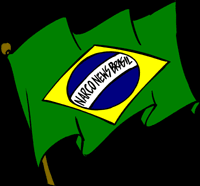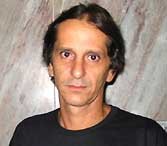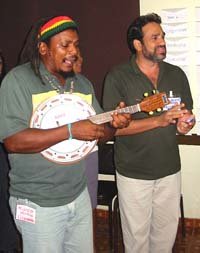


"President Lula, listen to the experience of your countrymen!"
Northern Brazil, after a late start, leaps to the front of drug policy reform creatively and popularly

By Adriana Veloso
Part VII in a Series, Reported from Brazil
April 10, 2003
While the south and southeast of Brazil saw the start of the Harm Reduction movement in the early 1990s, in most parts of the northeast the field work didn’t begin until the year 2000.
Marco Manso, known to his friends as Marcão, was one of the first Harm Reduction workers in the Northeastern coastal state of Bahia, where today he is president of the Bahia Harm Reduction Association. He remembers that the first efforts to give clean needles to drug users to impede the spread of diseases had to be carried out discreetly: “When we exchanged needles, we had to hide the used ones in boxes and take them home, to throw them away the next day.”
 Marcão and Paulinho |
Paulinho, tells that the work in Fortaleza started with a question: “Will needle exchange be as effective in our region as it was in others?” That was why he and his colleagues began by speaking with people from the poorest comunitites in town about the use and abuse of drugs. “We showed how some very common diseases, like hepatitis were contracted”.
Hepatitis is also an issue of public health in the border state of Acre – near Bolivia and Peru – where great part of the population has been in contact with some form of the disease. Ricardo Carpaneda, from the Harm Reduction Network of the state of Acre, says that hepatitis soon “became a bigger problem then HIV.” The work that started in 2001, with a great support from the Brazilian Association of Harm Reduction (ABORDA, in its Portuguese initials) by talking with the drug users in the communities where they were located.
“Until then nobody had done anything to know how our people could be attended to,” he explains.
The observation made by these harm reduction workers showed that “in the North and Northeast there is not a great volume of users of injected cocaine,” tells Carpaneda. It was then that the harm reduction movement widened its work and was not only doing needle exchange and started to attend to the needs of others, too.
In Recife, the capital of Pernambuco state, the results were similar. Marcílio Cavalcanti Lima, today the coordinator of the Association of Users of Alcohol and Other Drugs of Pernambuco, and also coordinator of the Pernambucana Harm Reduction Network, remembers that the results of investigating the needs of the users led them to “start to do harm reduction with other drugs.”
A Lack of Information
The lack of information regarding public heath all over the country, not only among drug users, is an issue highlighted by everyone, from the South to the North. “We have to unmask the unreliable database that we have in Brazilian public heath nowadays,” says Carpaneda.
 Marcílio Cavalcanti |
In Fortaleza, after this first moment of getting to know the constituency, or “when there was already an integration, a mutual comprehension, the users understood that we weren’t doctors or police officers,” as says Paulinho. Then the contact with the drug users and the communities where they live could be better established.
The Association of Users of Alcohol and Other in Recife was a vanguard. Cavalcanti tells that, “it became pretty clear that when people were drunk or stoned they didn’t have the same criteria in the choice of sexual partners and they had difficulties negotiating the use of condoms.”
Starting by getting the information of the constituency they would work with, the actions became more coherent with the reality. “We observed that treating the alcohol harm reduction in the same way we ‘d treat cocaine, crack and other illicit drugs, that reaching a larger number of people was possible with less resistance,”explains Cavalcanti.
Who Needs the Police?
The political resistance to Harm Reduction is very clear from the history of movement’s origin in Santos. Still, has the police repression issue been solved?
 Marcão Manso and Adalberto Ferreira, from Recife |
In the Northeast, where is not protected by local law, the harm reduction work is being tolerated, at least to certain point, by the local authorities. For instance, “during the carnival, we created a publicity campaign called ‘Drugs: if you use, don’t abuse,’ remembers Cavalcanti. He stresses that, “Recife City Hall did the street posters for alcohol harm reduction, but the User’s Association was in charge of that part of the campaign that dealt with the prohibited drugs.”
Bahia faces a harder situation. Marcão tells that “the crack is the bigger problem today, because the users left injected cocaine and changed for crack stones.” The “Unity-Mobile” of Bahia’s capital City of Salvador – yes, the Harm Reduction Project has its own car – expanded access to many drug users in recent months. Now, with the “Unity-Mobile,” the harm reduction program in Salvador still has five thousand pipes for crack users that it is unable to distribute in the field.
The hesitation, on the part of the harm reduction workers, is always the same: fear of being prosecuted as a drug dealer. Marcão tells that, “we could exchange the pipes in the streets, but we are worried about the harm reduction workers that have been arrested several times. In the dawn hours, when the police officer arrives in the place where the drug users are hanging and he finds someone with 50 pipes, before you can explain him that you are a harm reduction worker you have already been beaten up,” he explains.
When sharing pipes the drug user is venerable to diseases such as herpes, tuberculoses, hepatitis and the HIV virus. “In the ritual of crack usage, the person gets wounds in the lips and the gums and this is a door for diseases to come in,” says Marcão.
The Association of Users of Alcohol and other Drugs “was created to function as an union,”explains Cavalcanti. This union is realizing a field work in an area of Old Recife, “where there are many young users of illicit drugs,” The educational work includes the clarification that according to Brazilian law no one can be arrested under the influence of drugs. “The police officer cannot arrest you since you’re not in a condition to be examined or to prove your innocence,” explains Cavalcanti.
In the state of Acre, Carpaneda tells that “we have a good political situation here and I wish it was like this in other regions of the country. It’s time to have this openness because it’s pretty clear that harm reduction is a public health policy.”
Creative Solutions
 Paulinho: art as an agent |
He tells that “retired professors were contacted to work as volunteers,” and as a result the material truly comes from “the inside,” as it is, “designed by male and female drug users and elaborated with the knowledge that we gained in the practice of the social harm reduction.”
For Paulinho to deal with the political sphere and with the drug treatment clinics that work with the concept of abstinence is part of a process. “It was terrifying to them to understand that harm reduction is a complement, not a substitution,” he explains, clarifying that, “there are various strategies: the repression of drug use, the therapeutic clinics for abstinence, and there is also the strategy of harm reduction.”
The difference is that this last one deals with the person, not with the drug.
“Something that the harm reduction leaves as a teaching is that, in the field no only needles are exchanged but also, information, care and the ears for someone that perhaps never had someone to talk about the abuse of drugs”, explains Carpaneda.
“President Lula, listen to your countrymen!”
A union leader, like Brazil’s President Lula da Silva, Cavalcanti realizes that in the fourth month of the new administration, “the movement of professional and non governmental organizations is insufficient, because they never went to the organized movement of the workers to discuss this issue.”
 Ricardo Carpaneda |
The change to the prohibitionist drug policies is coming from below, as our Publisher Al Giordano wrote.
The harm reduction movement, differently from that of the therapeutic clinics, is made up of “people that even without a degree in medicine are developing excellent work methods that should be essential to the state,” says Carpaneda. “The government would take much more time to form and train professionals to work with this constituency, and the harm reduction movement came and served these methods to the government on a silver platter.”
An organized Civil Society is taking care of its own people, filling in the vacuum left by a state machine that is addicted to a model in which the oligarchies have always had the power. Now, what the people expect from the first left-wing government in Brazilian history, is the sensibility to look at the other not with compassionate condescension, but, rather, with the solidarity of companeiros. After all, nowadays the highest manifestation of national power comes from this base.
A Drug Policy from Below
Read Part II of this Series:
Drug Users and Addicts are “Self-Organizing” in Brazil
Read Part III of this Series:
130 Drug War Opponents Gather in São Paulo
Read Part IV of this Series:
Brazil Health Official Slams Current Drug Policy
Read Part V of this Series:
The Marginal Diplomat Explains “Organized Crime” in Brazil
Read Part VI of this Series:
The History of Brazilian Harm Reduction
Read Part VIII of this Series:
The Marketing of Drug War Myths
Lea Ud. el Artículo en Español
Leia este artigo em português
- The Fund for Authentic Journalism
For more Narco News, click here.




